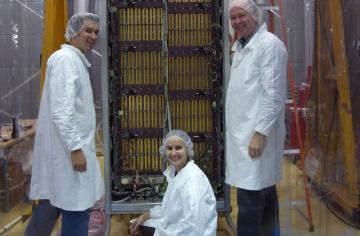Antimatter matters: T2K, TRIUMF, VISPA, ATLAS, ARIEL & more
- Tara Sharpe

Try to imagine holding one trillion subatomic particles between two cupped hands.
The elaborate choreography of subatomic particles would of course be invisible to the naked eye, but for years now, UVic experts have been tracking the complexities of this very elusive behavior using sophisticated equipment. In recent months, their research has brought us even closer to holding the answers to the beginnings of the universe and its building blocks.
In simple terms, antimatter is like a ‘film negative’ or mirror reflection of matter; when a particle meets its equivalent antiparticle, the two extinguish each other in a flash of energy. After the Big Bang, matter and antimatter were present in equal amounts, and should have annihilated each other; but now matter dominates in the universe.
Why are we still here and where did the rest of antimatter go? These are two of the biggest questions of particle physics.
Thanks to the T2K experiment in Japan, we get yet another hint. For generations, particle physicists thought matter and antimatter behaved identically. In the mid-1960s, a tiny but definite difference was detected between matter and antimatter, proving the two are not completely symmetrical. Recent T2K findings relate to a ghostly particle, the neutrino, which was caught “flip-flopping” during experimentation. The spontaneous flip of one type of neutrino into another could help explain the asymmetry.
“This result gives the first indication that neutrino mixing is complete, which could be the key to understanding the matter-antimatter paradox,” says UVic’s Dr. Dean Karlen (physics and astronomy), the R. M. Pearce Professor of Physics and one of the leaders of the T2K project. The UVic team also includes a postdoctoral fellow and several students.
These initial T2K findings were shared publicly June 14 by TRIUMF, Canada’s national lab for particle and nuclear physics. TRIUMF was co-founded by UVic, UBC and SFU in the 1960s and is owned and operated as a joint venture by a consortium of Canadian universities.
The T2K accelerator lab was damaged by the March 2011 earthquake, but staff expect to complete their recovery work by the end of this year and continue the experiment early next year.
Thousands of kilometres away from Japan, UVic remains in the centre of the world’s biggest science experiment. The 27-km Large Hadron Collider (LHC), buried 100m underground near Geneva, is a giant ring built by the European Laboratory for Particle Physics (CERN) to accelerate beams made up of trillions of protons into deliberate head-on collisions.
The UVic ATLAS team was responsible for designing and building several crucial components, in collaboration with TRIUMF colleagues, of one of two large detectors that records the debris from the collisions.
The project greatly benefited from early work by UVic particle physicists Drs. Alan Astbury and Richard Keeler. Now the UVic-ATLAS team includes physics professor Dr. Michel Lefebvre, founding spokesperson of the ATLAS-Canada project currently led by UVic adjunct professor Dr. Rob McPherson, and also Drs. Robert Kowalewski, Justin Albert, Randall Sobie and Isabel Trigger as well as more than 20 students, associates, technicians, computer experts, engineers and scientists.
The amount of data from the LHC is rapidly accumulating, and the UVic ATLAS team is getting ready in the build-up to the 2011 Europhysics Conference on High-Energy Physics, a major international conference taking place this summer in France.
Also located at CERN, the ALPHA project was successful in storing antimatter for over 16 minutes. Normally any antiatoms coming in contact with the matter in the walls of an ordinary bottle would be instantly extinguished. But a special “magnetic bottle” was used to bottle and hold antimatter. UVic’s participation is through adjunct faculty member Dr. Art Olin, a TRIUMF scientist. The results were published online in a June 2011 Nature Physics paper.
On June 15, Dr. Rolf-Dieter Heuer, director general of CERN, received an Honorary Doctor of Science from UVic. At present, Canada is not a member of CERN, but Heuer was visiting Canada in hopes of changing that. For more than two decades, UVic particle physicists, experts and students have contributed to CERN-based projects, and UVic continues to be at the forefront of the quest to track and analyze the mysterious movements of matter and antimatter, explore space and time, and probe the possible existence of new dimensions.
Earlier this year, UVic established the Victoria Subatomic Physics and Accelerator Research Centre (VISPA). “We’re very excited about VISPA, which builds on the longstanding strength of particle physics research at UVic and positions us to take it to the next level,” says Dr. Bob Kowalewski, chair of UVic’s Department of Physics and Astronomy. Dr. Karlen is the centre’s director.
Past coverage on UVic subatomic research includes stories on the ATLAS and ARIEL experiments, BaBar collaboration and new STEHM telescope. Search The Ring archives and the UVic Communications webpage for more.
Further info is also available online about VISPA, CERN & LHC, TRIUMF and T2K.

